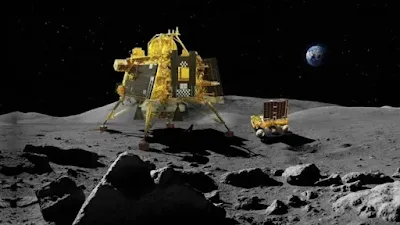-Tweesha Agarwal
What Will You Find in This Article?
- Chandrayaan-3 Mission Facts and FAQs
- Facts About Vikram Lander
- Facts About Pragyaan Rover
- Russia's Luna 25 and Luna 26 Missions in Brief
- China's Chang'e Lunar Missions in Brief
- Chandrayaan-2 Mission in Brief
- Chandrayaan-1 Mission in Brief
Important Facts About Chandrayaan 3 Mission
The Chandrayaan-3 mission's success is a testament to the hard work and dedication of the Indian Space Research Organisation (ISRO), and it demonstrates India's growing capabilities in space exploration. The successful Moon mission is trending on Twitter as it has accomplished a number of significant milestones, including:
1. It is the first Indian mission to successfully land on the Moon.
2. It is the first mission to land on the lunar south pole, a region that is of great scientific interest.
3. India became the fourth country to successfully soft land on the Moon, after the United States, Russia and China.
For all the latest technology news updates, subscribe to our blog
When was India's Chandrayaan 3 launched?
The India's moon mission was launched on July 22, 2023, and consisted of an orbiter, Vikram lander and Pragyaan rover as per the latest news update.
Goals Of Chandrayaan-3 Mission
Chandrayaan-3 carried a suite of sophisticated instruments to study the Moon's surface composition, mineralogy and water resources. It landed on the lunar south pole, a region of scientific interest. The South Pole is believed to contain water ice and other resources. The moon mission is expected to accomplish a number of scientific goals, including:
- Mapping the Moon's surface composition and mineralogy.
- Identifying potential water ice deposits.
- Studying the Moon's exosphere and magnetic field.
- Measuring the Moon's seismic activity.
The mission's findings will help scientists to better understand the Moon's past and present, and they could also pave the way for future human exploration of the Moon.
For all the trending on Twitter and the latest technology news updates, subscribe to our blog
Important Facts About Vikram Lander
The Vikram lander is a significant achievement for India's space program. It is the first Indian spacecraft to land on the Moon, and it is the first spacecraft to land on the lunar south pole.
The Vikram lander is a robotic spacecraft that is part of the Chandrayaan-3 mission. It was designed to deliver the Pragyaan rover to the lunar south pole and to provide it with power and communication support.
The lander is named after Vikram Sarabhai, the founding father of the Indian space program.
The lander weighs about 1,325 kilograms. It is powered by a solar panel and a lithium-ion battery.
The Vikram lander landed on the Moon on August 23, 2023. The lander is currently functioning normally, and it is providing power and communication support to the Pragyaan rover. The lander has a communication system that can transmit data to the Pragyaan rover and to the Chandrayaan-3 orbiter.
The Vikram lander has a suite of instruments to study the Moon. These instruments include:
1. A Langmuir probe to measure the plasma density and temperature of the lunar atmosphere.
2. A seismometer to measure seismic activity on the Moon.
3. A thermal imaging camera.
4. A radar altimeter to measure the altitude of the lander above the lunar surface.
Important Facts About Pragyaan Rover?
The Pragyaan rover is a six-wheeled robotic vehicle that is part of the Chandrayaan-3 mission.
It is designed to explore the lunar south pole, which is a region of scientific interest because it is believed to contain water ice and other resources.
The Pragyaan rover is carrying a suite of instruments to study the Moon's surface composition, mineralogy, and water resources. These instruments include:
1. A laser-induced breakdown spectroscopy (LIBS) instrument to analyse the elemental composition of the lunar surface.
2. A Raman spectroscopy instrument to study the mineralogy of the lunar surface.
3. A thermal imaging camera to map the temperature distribution of the lunar surface.
4. A subsurface neutron spectrometer to search for water ice and other hydrogen-bearing compounds beneath the lunar surface.
The Pragyaan rover landed on the Moon on August 23, 2023, and it began its exploration of the lunar south pole shortly thereafter. The rover has already collected a significant amount of data, and it is expected to provide new insights.
What information the Pragyaan rover has collected so far?
- The Pragyaan rover is still in the early stages of its exploration of the lunar south pole, but it has already made some significant discoveries.
- The rover has detected the presence of sulfur, aluminium, calcium, ferrous iron, chromium, titanium, manganese, silicon, and oxygen on the lunar south pole.
- The rover has also detected water ice in the lunar soil.
- The rover has measured the temperature of the lunar surface, which can reach up to 60 degrees Celsius during the lunar day.
- The rover has also imaged the lunar surface, including the Vikram lander and the surrounding area.
What Challenges Chandrayaan-3 Mission has to face?
The Chandrayaan-3 mission faced a number of challenges, including:
- The complex nature of the mission, which involved coordinating the launch and landing of three spacecraft.
- The harsh environment of the Moon, which is characterized by extreme temperatures and radiation.
- The need to develop new technologies for lunar exploration, such as the Pragyaan rover.
Major Challenge: The Moon's Day and Night Cycle
The Moon's day and night cycle is much longer than Earth's, lasting for about 14 Earth days each. This is because the Moon rotates on its axis once every 27.3 Earth days.
During the lunar day, the Sun shines on the Moon constantly, providing solar power for the rover. However, during the lunar night, the Moon is plunged into darkness, and the rover must rely on battery power.This can be a challenge for the rover, as it needs to conserve its battery power in order to operate through the long lunar night. A rover typically does this by going into a low-power hibernation mode during the night.
In addition, the Moon's extreme temperature changes can also affect rover exploration. During the lunar day, the temperature on the Moon's surface can reach up to 127 degrees Celsius (260 degrees Fahrenheit). However, during the lunar night, the temperature can drop to as low as -173 degrees Celsius (-280 degrees Fahrenheit).
A rover must be designed to withstand these extreme temperature changes. A rover typically uses insulation and other techniques to stay cool during the lunar day and warm during the lunar night.
The Chandrayaan-3 mission is scheduled to take place during the lunar summer when the days are the longest and the nights are the shortest. This will give the Pragyaan rover more time to operate during the day and less time to rely on battery power during the night.
The Pragyaan rover is also designed to withstand the Moon's extreme temperature changes. It is equipped with insulation and other techniques to stay cool during the lunar day and warm during the lunar night.
Chandrayaan-3 Mission Impact
The success of the Chandrayaan-3 mission is a major achievement for India, and it demonstrates the country's growing capabilities in space exploration. The mission is also expected to make significant contributions to our understanding of the Moon's past and present, and it could also pave the way for future human exploration of the Moon.
Chandrayaan-3 Mission and Future Lunar Exploration
The success of the Chandrayaan-3 mission is a positive step forward for future lunar exploration. The mission's findings are expected to help scientists better understand the Moon and to identify potential resources that could be used for future missions.
The mission's success demonstrates that India is a leading player in the global space community, and it is well-positioned to make significant contributions to future lunar exploration missions.The Chandrayaan-3 mission is a historic achievement for India and for the global space community. The mission is a testament to the resilience and determination of the ISRO.
Russia's Luna 25 and Luna 26 Missions
On August 11, 2023, Russia launched its Luna 25 mission, also known as the Luna-Resource Lander. The mission was intended to land on the Moon and collect samples of its soil. However, the spacecraft failed to reach lunar orbit and is now lost in space.
The cause of the Luna 25 mission failure is still under investigation, but it is believed to have been caused by a problem with the spacecraft's upper stage engine.The Luna 25 mission failure was a setback for Russia's space program, but it is not the first time that Russia has failed to land a spacecraft on the Moon. In 2011, Russia's Phobos-Grunt mission also failed to reach its destination.
Despite these setbacks, Russia is still committed to lunar exploration. Russia plans to launch a new lunar mission, Luna 26, in 2024. Luna 26 will be a sample return mission, and it will attempt to collect samples of the Moon's soil and return them to Earth.
China's Chang'e Lunar Missions
China is planning to launch a new lunar mission, the Chang'e 7 mission, in 2024. The Chang'e 7 mission will be a sample return mission, and it will attempt to collect samples of the Moon's soil and return them to Earth.
China has also launched a number of other lunar missions in recent years. In 2020, China launched the Chang'e 5 mission, which successfully collected samples of the Moon's surface and returned them to Earth. This made China the third country, after the United States and Russia, to successfully return lunar samples to Earth.In 2021, China launched the Chang'e 6 mission, which is currently orbiting the Moon. The Chang'e 6 mission will attempt to collect samples of the Moon's polar surface and return them to Earth.
China is also planning to launch a lunar rover mission, the Chang'e 8 mission, in 2025. The Chang'e 8 mission will explore the Moon's south pole.
China is also planning to launch a number of other lunar missions in the coming years. These missions include:
Chang'e 9: A mission to explore the Moon's far side
Chang'e 10: A mission to study the Moon's polar regions
Chang'e 11: A mission to build a lunar base
The Chandrayaan-2 Mission
The Chandrayaan-2 mission was India's second attempt to land on the Moon. It was launched on July 22, 2019, and consisted of an orbiter, lander and rover. The orbiter successfully entered lunar orbit, but the lander crashed on the Moon's surface on September 7, 2019.
The cause of the lander crash was a software glitch. The lander's software incorrectly calculated its altitude above the Moon's surface, which caused it to descend too quickly and crash.The Chandrayaan-2 mission failure provided valuable lessons. The ISRO has used these lessons to improve the design and software of the Chandrayaan-3 lander.
Chandrayaan-1 Mission and its Key Findings
Chandrayaan-1, India's first mission to the Moon, was launched on October 22, 2008, and operated until August 29, 2009. The mission included an orbiter and an impactor.
The orbiter carried 11 scientific instruments built in India, USA, UK, Germany, Sweden and Bulgaria.The impactor, called the Moon Impact Probe (MIP), was deliberately crashed into the Moon to study the lunar surface composition.
Chandrayaan-1's primary science objective was to prepare a three-dimensional atlas of both the near and far sides of the Moon.
The mission also conducted chemical, mineralogical, and photo geologic mapping of the Moon.
Chandrayaan-1 made significant discoveries, including the presence of water ice on the Moon.
Here is a summary of Chandrayaan-1's key findings:
1. The presence of water ice on the Moon.
2. The distribution of elements and minerals on the Moon's surface.
3. The structure and composition of the Moon's crust.
4. The Moon's gravity field and magnetic field.
5. The Moon's tenuous atmosphere.










